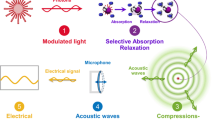Abstract
Sonoluminescence (SL) is a physicochemical phenomenon that is observed when a single or multiple air bubbles, excited by an acoustic field in water, collapse and emit light. Until nowadays, it is still an outstanding phenomenon in which acoustic energy is (partially) transformed into light. Along the years, some models have been proposed to explain sonoluminescence and a lot of experimental setups have been built in an attempt to reproduce and study it. Since the flash of light is forced to occur inside a resonant cavity (i.e., a glass flask filled with water) by using external circuitry, many efforts have been made to study the relationship between the phenomenon and the electrical and mechanical quantities involved in the experimental apparatus. Following this field of study, this paper proposes an electronic instrumentation system based on a FPGA device for performing automatic monitoring of the input signal applied to the resonator as well as the output response signal produced by it. The objective of using the automated setup is to collect data for characterizing the resonator frequency response in order to identify its input/output behavior. The key idea is to find out whether there is a linear circuit which might have analogous input/output characteristics that may be used to simulate the phenomenon in future studies.



Source: Courtesy of the Laboratory of Experimental and Applied Physics - LaFEA - CEFET/RJ







Source: Courtesy of the Laboratory of Experimental and Applied Physics—LaFEA—CEFET/RJ







Similar content being viewed by others
References
Barber, B. P., Hiller, R. A., Lstedt, R., Putterman, S. J., & Weninger, K. R. (1997). Defining the unknowns os sonoluminescence. Physics Reports, 281, 65.
Brenner, M. P., Hilgenfeldt, S., & Lohse, D. (2002). Single-bubble sonoluminescence. Reviews of Modern Physics, 74(2), 425.
Dellavale, D., Sonnaillon, M. O., & Bonetto, F. J. (2008). FPGA based multi-harmonic control system for single bubble sonoluminescence. In Programmable logic 2008—4th southern conference.
Gaitan, D. F., & Crum, L. A. (1990). Observation of sonoluminescence from a single stable cavitation bubble in a water/glycerine mixture frontiers of nonlinear acoustics. In M. F. Hamilton & D. T. Blackstock (Eds.), 12th ISNA (p. 459). Amsterdam: Elsevier.
Garcia, R. O., de Barros, A. L. F., Zachi, A. R. L., & Nogueira, A. L. M. A. (2014). Automation process to determine the resonance frequency in the sonoluminescence setup. Journal of Control, Automation and Electrical Systems, 25(4), 461–469.
Hammer, D., & Frommhold, L. (2001). Topical review, sonoluminescence: How bubbles glow. Journal of Modern Optics, 48, 239.
Johnson, D. E., Johnson, J. R., Hilburn, J. L., & Scott, P. (1997). Electric circuit analysis. Upper Saddle River: Prentice-Hall, Inc.
Monmasson, E., & Cirstea, M. N. (2007). FPGA design methodology for industrial control systems—A review. IEEE Transactions on Industrial Electronics, 54(4), 1824–1842.
Putterman, S. J., & Weninger, K. R. (2000). How bubbles turn sound into light. Annual Review of Fluid Mechanics, 32, 445.
Schaumann, R., et al. (2001). Design of analog filters. Cary: Oxford University Press.
Sewan, F., Beiling, C. D., & Fung, S. (2000). Stability control of single bubble sonoluminescence light. Article in Physica B Condensed Matter, 279(1), 233–236.
Vignoli, L. L., de Barros, A. L. F., Thomé, R. C. A., Nogueira, A. L. M. A., Paschoal, R. C., & Rodrigues, H. (2013). Modeling the dynamics of single-bubble sonoluminescence. European Journal of Physics. https://doi.org/10.1088/0143-0807/34/3/679.
Yuan, L., Cheng, H. Y., Chu, M. C., & Leung, P. T. (1998). Physical parameters affecting sonoluminescence: A self-consistent hydrodynamic study. Physical Review E, 57, 4265–4280.
Zanzane, A., & Rawat, S. (2016). Sram-based FPGA implementations of cryptographic circuits for fault injection and fault tolerant techniques. In Advances in electronics, communication and computer technology (ICAECCT), 2016 IEEE international conference on (pp. 176–179). IEEE.
Acknowledgements
The authors are very thankful for the financial supports received from the Brazilian agencies such as CNPq (301868/2017-4), CAPES (BEX 5383/15-3) and FAPERJ (E-26/213.577/2015, E-26/216.730/2015, E-05/2015-214814 and E-03/2017-203.204).
Author information
Authors and Affiliations
Corresponding author
Additional information
The authors are very thankful for the financial supports received from the Brazilian agencies such as CAPES (BEX 5383/15-3), (PNPD-PhD scholarships) CNPq and FAPERJ (E-26/110.087/2014, 13.577/2015, /216.730/2015 and E-26/200.820/2017).
Rights and permissions
About this article
Cite this article
de Barros, A.L.F., Samyn, L.M., Sobral, J.S. et al. Frequency Response Characterization of a Sonoluminescence Acoustic Resonator by Using a FPGA-Based Instrumentation. J Control Autom Electr Syst 30, 104–112 (2019). https://doi.org/10.1007/s40313-018-00431-0
Received:
Revised:
Accepted:
Published:
Issue Date:
DOI: https://doi.org/10.1007/s40313-018-00431-0




